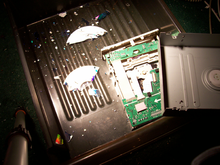- Compact Disc shattering
-
CD shattering, DVD shattering (more recently Blu-ray shattering) and optical disc shattering , a phenomenon also known as exploding CDs, occurs when a optical disc shatters inside a high speed optical disc drive (48× or higher CD-ROM unit) with a loud cracking sound. Typically, the disc and the drive will be ruined. Fragments of the broken disc may be expelled through the front of the drive at high speed and cause physical injury.
Maxell's senior marketing manager, Dawn Wortman has been quoted as saying there is very little danger at 48×, and danger of shattering only becomes significant above 48× (or 52×).
"The 48X standard offers customers outstanding performance without the risks associated with 52X speeds," says Dawn Wortman.[1]
A disc shatters when it fails to support the centripetal force required to keep all parts of the disc moving circularly. The velocity of the edge of a 120 mm disc rotating at 10,350 RPM is approximately 65 m/s. (234.1 km/h, 145.5 mph) To remain in circular motion about the spindle, the disc edge accelerates at about 7,200 G. The force causing this acceleration is transmitted through the disc itself and is balanced by an opposite force on the other side of the disc. Thus, a disc begins to fail when it can not handle these forces, and a failing disc can then completely shatter due to the imbalance of forces around the disc.
The television series MythBusters conducted experiments in which they succeeded in shattering otherwise undamaged control CDs at speeds in excess of 23,000 RPM. A 52× drive using CLV needs to go up to 27,500 RPM when reading the inner track, however no drive is known to actually reach those speeds, reading data at a slower rate on inner tracks and only achieving 52× read speeds on the outer track. (In other words 52× is the peak read speed, not the typical rate.)
Typically a 52× drive will actually max at around 11,500 RPM. At this speed it is still possible for a CD to shatter with enough force to come flying out of a drive. When brittle media is put in the drive, small cracks can occur on the inner hole of the disc. Once these cracks reach a critical length, they propagate in an instant and the disc shatters. The critical length of the crack is a function of the rotational speed. If the drive is spinning below 8,000 rpm or around 40× the critical length of the crack is long enough that the crack enters the disc media before becoming critical. At this point the crack enters the media, the drive detects the error and slows down.
Many drive manufacturers now have more aggressive back-off algorithms that detect issues with the disc and this reduces the chance of the disc shattering. Some companies also deliberately slow their drive down to 40× and the user has to press a combination of buttons to allow 52× speed to be reached. In doing so, the user takes the responsibility for any issues arising from disc shattering.
Rotation speed can be controlled/limited by software. However, this is defeated or largely crippled in more recent drives which only offer one selectable speed when queried by the software, rendering the user unable to slow the drive to even slower but safer speeds (i.e. 8x). Saving older discs therefore becomes riskier as a result of the discs age and the forced high speed of the drive.
See also
References
- ^ Lasse Penttinen (2002-11-19). "Maxell introduces 48x CD-R media and warnes about the risks of higher speeds.". http://www.afterdawn.com/news/article.cfm/2002/11/19/maxell_introduces_48x_cd-r_media_and_warnes_about_the_risks_of_higher_speeds. Retrieved 2011-09-02.
External links
- The Case of the Exploding CD-ROM Record
- Life in the Fast Lane Can be a Disc-Shattering Experience
- PowerLabs High Speed CD-Rom Experiments
- Maxell Introduces 48x Media
- Guide to Safer High Speed CD Use
- A UK site giving more information about CD Rom shattering
- Paper on the Structural Integrity of CD Rom Discs
Categories:
Wikimedia Foundation. 2010.


